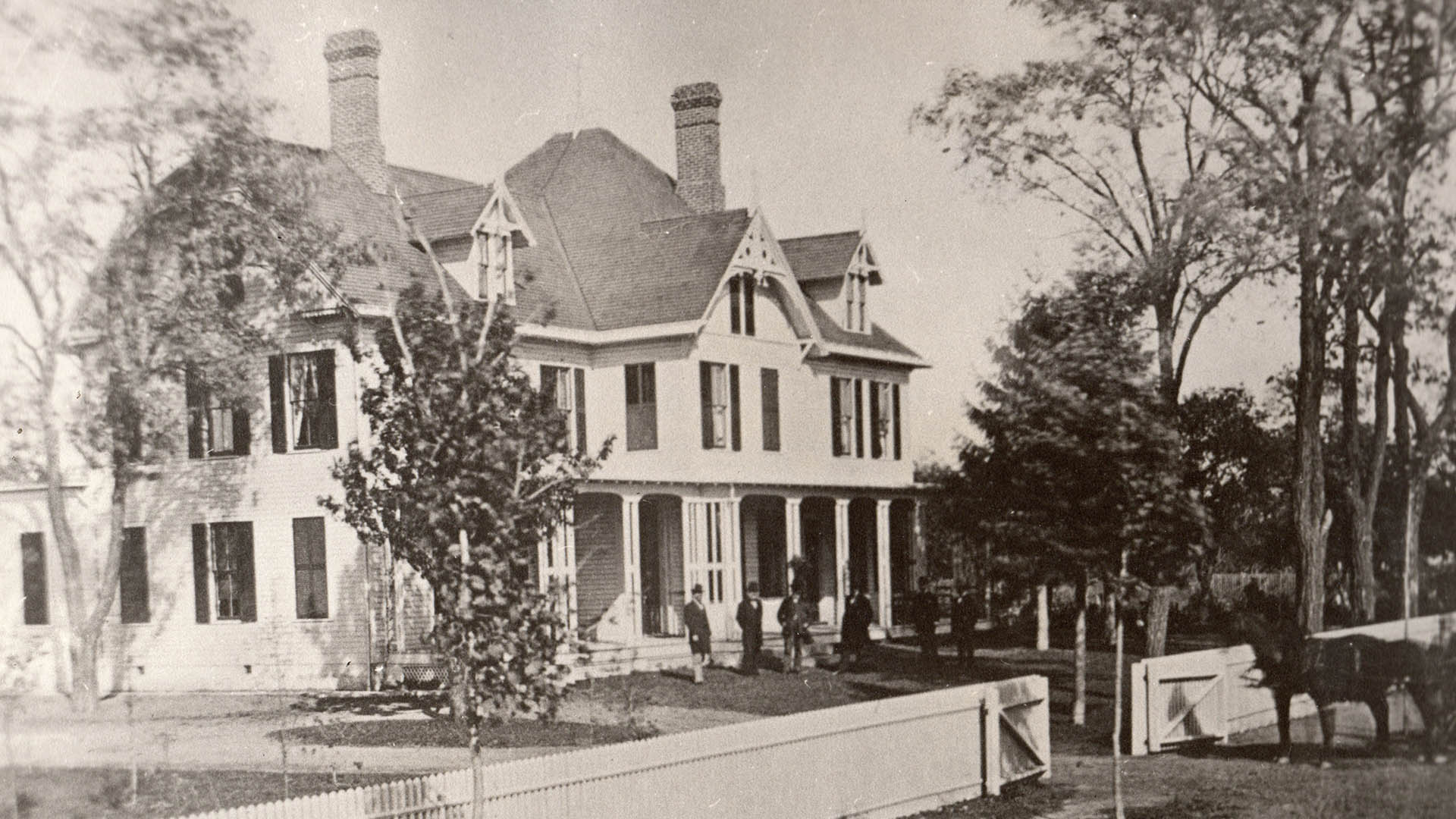
Much of James A. Garfield’s legacy was forged before he made his home in Mentor. As a former college president, abolitionist, war hero, and statesman, he was well-known and well regarded by many of his era.
Although his time in Mentor was brief, his impact was substantial.
It has been 143 years since his legacy was sealed by an assassin and nowadays, he isn’t as well known as he should be – even here in Mentor. At the time, he was among the most respected members of Congress drawing admiration from both sides of the aisle.
His assassination gripped the nation, but as the years passed, so did his legend. A self-made man in every respect, his life was full of lore, but we’d like to shine some light on his time in our hometown.
Born in 1831 in Orange Township (now Moreland Hills), Garfield was the youngest of four surviving children. His father died when he was just 18 months old and his mother never remarried, choosing instead to raise her family on her own.
Growing up in poverty was painful for young James and he was proud of rising above his poor upbringing. His days were filled with farmwork; his evenings with reading and self-improvement which led him from the farmhouse to the White House.
In 1872, the village of Hiram was technically home to then 19th District Ohio Congressman Garfield when he was impacted by redistricting. After spending years in Washington D.C., he sought a place to set down roots where he could teach his sons the merits of farmwork.
A bucolic setting far from the bustle of the capital is exactly what he had in mind so Garfield looked north towards the heart of his district in Mentor and purchased the 120-acre Dickey farm in 1876 for $17,500. Soon, they would add another adjoining 40-acres.
Work got underway almost immediately renovating the 9-room farmhouse into what the Garfields envisioned as their forever home. Both he and his wife Lucretia were heavily involved in the effort as they settled into their new community.
Garfield preached at the Disciples of Christ Church which is now Old Council Hall. He was integral in the establishment of the West Mentor Post Office and was known to spend time chatting with friends in front of what is now the Gray-Coulton Building.
Restoration work continued on their home until Garfield set off for the Republican National Convention in June 1880. He had already been elected to the Senate after spending 17 years in the house and was on a mission to nominate and advocate fellow Ohioan John Sherman’s bid for presidency.
After 36 ballots, and somewhat to his chagrin, it was Garfield who would come home with the nomination. Aside from a few short trips, Garfield spent most of the summer in Mentor during his campaign welcoming curious visitors from his front porch.
With a population of just 540, Mentor was little more than a whistlestop between Willoughby and Painesville. An estimated 17,000 people from across the country came by train or trail to visit what would become known as Lawnfield – a name coined by the press much to Garfield’s amusement.
Many of the visitors disembarked from the small railroad stop on the Lake Shore and Michigan and Southern Railroad which traversed his property, then trudged up the path that cut through their fields. Others came by horse and carriage along Mentor Avenue.
At the time, the image of the gentleman farmer was a popular one and it was a role Garfield could genuinely portray. What was not popular at the time was for a candidate to campaign on their own behalf. Surrogates were relied upon to do the heavy lifting.
As people started descending on his property, he wanted to be a good host but also recognized the opportunity to appeal to potential voters. So, he happily ventured outside to talk to his guests who wanted to know more about him. The front porch campaign was born.
“He was very good at tailoring the message to the group he was talking to,” says Todd Arrington, Ph.D., site manager for the James A. Garfield National Historic Site, “If he was talking to a group of German immigrants, he would talk to them in German. If he was talking to a group of businessmen from Cleveland or Indianapolis, he would talk to them about the interests of business.”
Groups large and small flocked to the family farm including businessmen, women’s groups, choirs, Civil War veterans, immigrants, and others. He addressed a group of black Civil War veterans who journeyed to show their support, “You were not made free to merely be allowed to vote, but in order to enjoy an equality of opportunity in the race of life, and to stand equal before the law.”
Amidst the festive atmosphere, serious political work still needed to be done.
The Stalwarts were still smarting from their defeat at the convention and Garfield, who was aligned with the Half-Breeds, knew that he needed their support to secure the presidency. Although the Vice-Presidency was offered to Stalwart Chester A. Arthur, it wasn’t enough, and the response to his continued outreach was tepid at best. He traveled to New York, only to be snubbed by New York Senator and Stalwart boss Roscoe Conkling.
On September 28, 1880, an entourage including former president Ulysses S. Grant and Conkling traveled to Mentor to meet with Garfield after addressing a crowd of 40,000 people in Warren. The group was introduced to 200 local supporters gathered around Garfield’s porch before being led inside where Mrs. Garfield served some light refreshments. Some of the gentlemen then adjourned to Garfield’s upstairs study to smoke cigars and talk politics. One hour later, they were gone.
What happened during that conversation? That’s up for debate. Stalwarts claimed that a deal had been struck where Garfield would consult with their faction regarding appointments for federal service positions in New York. Garfield, on the other hand, recorded that “I had no private conversation with the party, but the call was a pleasant and cordial one all around.”
The ballyhooed Treaty of Mentor never happened but the claims resulting from that meeting, and the growing tension between factions in the party, would ultimately prove fatal for Garfield.
October came and went with crowds continuing to descend on Mentor as Garfield prepared to find out if was heading to the White House or Senate chambers.
Mere steps from the rear of the home sits a small outbuilding that was originally built by the Dickeys as a bunkhouse for farm laborers. Garfield had it converted into a correspondence office. It was here that he received the telegram notice on November 2, 1880, notifying him that he had been elected 20th President of the United States.
After the election, those seeking appointments continued to trek to Mentor to personally plead their case. Garfield did what he could to manage those meetings with grace. Much of the winter was spent by the President-elect preparing for his term including the selection of his cabinet.
On February 28, 1881, amongst the cheers of friends and neighbors as well as the Lane Cornet Band, Garfield boarded a train leaving Mentor and his former life behind.
To his throng of supporters, he said, ‘What awaits me I cannot now speak of; but I shall carry to the discharge of duties that lie before me, to the problems and dangers I may meet, a sense of your confidence and your love, which will always be answered by my gratitude. Neighbors, friends, constituents, farewell.'”
He would never set foot in Mentor again.
On July 2, 1881, a crazed office-seeker named Charles Guiteau would shoot the president at close range at the Baltimore and Potomac Railroad Station in Washington, D.C. This politically motivated act was the climax of tensions between Republican factions. Guiteau considered himself a Stalwart who believed Garfield was leading the country down the wrong path and killing Garfield would result in Arthur becoming president.
News of the shooting flashed across the nation. The message was, however, mercifully couched within earshot of the train car occupied by his young sons Irvin and Abram who were on their way home to Mentor.
Garfield was rushed to the White House and underwent months of grueling and bungled treatment. He died on September 19, 1881, in a small beach house in Long Branch, New Jersey, within a view of the ocean outside his window.
The nation was cast into mourning and donations poured into a subscription fund for the young widow and her children. The fund reached $360,000 which translates to an estimated $11 million today. With the mortgage paid off and the family’s roots planted firmly in Mentor, Mrs. Garfield set upon building a memorial library to house her husband’s books and correspondence. It is widely accepted as the first presidential library.
Lucretia lived in the family home for several more decades and would add a number of other buildings as well including the iconic windmill, the carriage house (which now serves as the visitor center), and the red tenant house.
In her later years, she also spent time in her Cleveland townhouse and wintered in Southern California with her daughter and son-in-law before building a home in Pasadena in 1904.
Lucretia Garfield died in 1918 at the age of 85. Her brother, Joseph Rudolph, lived at Lawnfield until he passed away in 1934. At that time, the Garfield children made the decision to donate the home to the Western Reserve Historical Society, who opened it as a museum in 1936. In 1980, the National Park Service (NPS) came on board as a partner to help operate and preserve the estate.
In the mid-1990s the National Park Service obtained $12.5 million in funding to rehabilitate and restore the buildings on the property. It was during this restoration that the home was repainted dark grey as opposed to the white that those in the community had become accustomed to.
The home was originally painted white during the President’s time but was repainted grey by Mrs. Garfield when the library was added in 1885. It was subsequently repainted white again at some point.
According to Arrington, the NPS sought to achieve a consistent experience from room-to-room as well as “inside and out”. The decision was made to restore the appearance of the property to when the library was added.
It’s hard to imagine Mentor as a sleepy little town. It’s equally hard to imagine the stir of activity that this community experienced in the summer of 1880. Today, James A. Garfield National Historic Site continues to welcome an average of 40,000 visitors each year on a quest to learn about the life and legacy of James A. Garfield.
To learn more or plan your tour, visit www.nps.gov/jaga/
